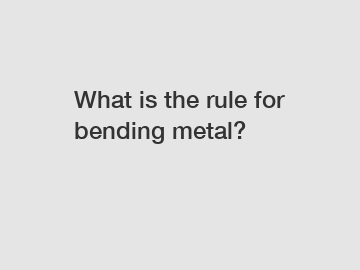What is the rule for bending metal?
What is the Rule for Bending Metal?
Metal bending is a widely used manufacturing process that involves altering the shape of metal by applying force. This process is performed using various techniques, tools, and machines to achieve the desired shape and form of the metal. However, bending metal is not as simple as it may seem. There are specific rules that need to be followed to ensure successful and accurate bending. In this article, we will explore the rule for bending metal and its importance in the manufacturing industry.
Understanding the Different Types of Metal Bending.

Before diving into the rule for bending metal, it's crucial to understand the different types of metal bending techniques. There are several common techniques used in metal bending, including:
1. V-Bending: This technique involves using a V-shaped die and punch to bend the metal into a desired angle. The metal is placed between the die and the punch, and force is applied to bend it.
2. U-Bending: In this technique, a U-shaped die and punch are used to create a U-shape bend in the metal. The metal is inserted between the die and the punch, and pressure is applied to form the desired bend.
3. Roll Bending: This technique involves passing the metal between a set of rollers to gradually bend it into a curved shape. Roll bending is commonly used in the production of tubes, pipes, and curved sections.
The Rule for Bending Metal.
The primary rule for bending metal is based on the material's mechanical properties and the bending angle. Each type of metal has its own unique characteristics, such as elasticity, tensile strength, and hardness, which affect its ability to be bent.
1. Minimum Bend Radius: The minimum bend radius is a critical factor when it comes to metal bending. It refers to the smallest radius that a material can be bent without causing any damage or deformation. The minimum bend radius varies depending on the type and thickness of the metal. Exceeding the minimum bend radius can lead to cracks, fractures, or even breakage of the metal.
2. Material Thickness: The material thickness also plays a significant role in metal bending. Thicker materials require more force and energy to be bent. It is essential to consider the thickness of the metal when determining the appropriate bending tool or machine to use.
3. Springback: Springback is the tendency of a metal to return to its original shape after being bent. This phenomenon occurs due to the metal's elastic properties. To compensate for springback, the bending angle is usually set to slightly over bend the metal, so it returns to the desired shape.
Importance of Following the Rules.
Following the rule for bending metal is crucial for several reasons:
1. Quality and Accuracy: By following the bending rule, manufacturers can ensure the quality and accuracy of the final product. Proper bending techniques help avoid defects and ensure that the metal retains its structural integrity.
2. Cost Efficiency: By avoiding excessive bending or incorrect bending techniques, manufacturers can save costs associated with material wastage, rework, and repair.
Contact Us.
Metal bending is a skill that requires experience, knowledge, and adherence to specific rules. If you have any questions or need assistance with metal bending, please feel free to contact us. Our team of experts is always ready to help you achieve the best results in metal bending processes.
The company is the world’s best panel bending machine, panel bending, panel bending machine supplier. We are your one-stop shop for all needs. Our staff are highly-specialized and will help you find the product you need.


